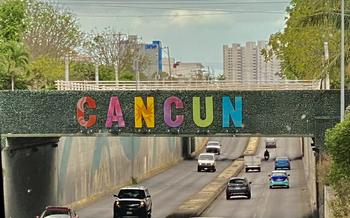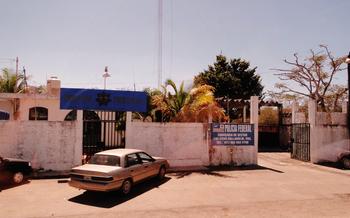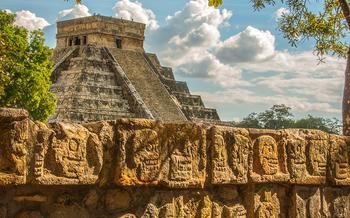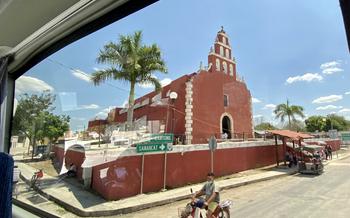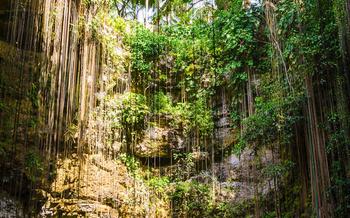
Cenote Zaci (in Valladolid)
- History of Cenote Zaci (Valladolid)
- Geological Formation of Cenote Zaci
- Cenote Zaci as a Sacred Mayan Site
- Exploring the Cave System of Cenote Zaci
- Relaxing and Sunbathing at Cenote Zaci
- Cenote Zaci's Cultural Significance
- Visiting Cenote Zaci: Practical Information
- Cenote Zaci Tours and Packages
- Cenote Zaci for Photographers
- Cenote Zaci: A Family-Friendly Oasis in the Heart of Valladolid
- Cenote Zaci's Contribution to the Local Economy
- Cenote Zaci and Sustainable Tourism
- Insider Tip: Cenote Zaci's Hidden Gem
History of Cenote Zaci (Valladolid)
Cenote Zaci holds a significant place in the history of Valladolid, Mexico. It served as a vital water source for the ancient Maya civilization, who viewed cenotes as sacred portals to the underworld. Archaeological discoveries at the site have revealed remnants of Mayan rituals, including offerings and artifacts, providing valuable insights into their cultural and religious practices. The cenote's unique geological formations and crystal-clear waters have also made it a popular destination for swimming, snorkeling, and cave exploration, attracting visitors from around the world.
Geological Formation of Cenote Zaci
The captivating beauty of Cenote Zaci is a testament to the intricate geological processes that have shaped the Yucatan Peninsula over millions of years. The region is characterized by a unique karst topography, where soluble rocks, primarily limestone, have been dissolved by acidic groundwater, creating an extensive network of underground caves and sinkholes. Cenote Zaci is one such natural wonder, formed when the roof of an ancient cavern collapsed, revealing the mesmerizing turquoise waters below.
The cenote's crystal-clear water is a result of the limestone composition of the surrounding rock, which acts as a natural filter, removing impurities and leaving behind pure, refreshing water. The limestone also contributes to the cenote's unique ecosystem, providing a habitat for diverse aquatic life, including fish, turtles, and even bats. The cenote's underground river system connects it to other nearby cenotes, creating a vast subterranean network that remains largely unexplored.
The geological formation of Cenote Zaci not only makes it a stunning natural attraction but also a valuable scientific resource. It offers a glimpse into the complex geological processes that have shaped the Yucatan Peninsula and provides insights into the region's rich biodiversity and fragile ecosystem.
Cenote Zaci as a Sacred Mayan Site
The Mayans revered cenotes as sacred portals to the underworld, known as Xibalba. Cenote Zaci held particular significance as a ceremonial site. They believed that the cenote's crystal-clear waters provided a direct connection to the gods and ancestors. Ancient rituals and offerings were conducted to appease the deities and seek their blessings.
Mayan legends depict cenotes as gateways to the afterlife, where souls embarked on a journey through the underworld. The Mayans believed that offerings thrown into the cenote would reach their deities, ensuring a safe passage for the departed. These offerings could include precious objects, food, or even human sacrifices during times of crisis.
Preserving the Mayan culture and traditions is a crucial aspect of Cenote Zaci's significance. The cenote serves as a reminder of their deep connection to nature, spirituality, and the belief in a cyclical existence. Visitors can still witness Mayan rituals and ceremonies performed at the cenote, offering a glimpse into the rich cultural heritage of the region.
Exploring the Cave System of Cenote Zaci
Venturing into the cave system of Cenote Zaci is an experience that unveils the hidden wonders beneath the surface. Guided tours lead visitors through the intricate network of underground chambers and tunnels, revealing awe-inspiring stalactites and stalagmites formations. These natural sculptures, formed by the continuous dripping of water over thousands of years, create an otherworldly landscape that captivates the imagination.
During the exploration, visitors may encounter ancient Mayan artifacts and pottery, remnants of a civilization that once revered these cenotes as sacred places. These artifacts offer a tangible connection to the past, providing a glimpse into the rich cultural heritage of the region.
However, it is crucial to emphasize the importance of conservation and preservation when exploring the cave system. Visitors should tread carefully, respecting the delicate ecosystem and avoiding touching or damaging the formations. Sustainable tourism practices ensure that future generations can continue to marvel at the beauty and wonder of Cenote Zaci's cave system.
Relaxing and Sunbathing at Cenote Zaci
Immerse yourself in the tranquility of Cenote Zaci, where relaxation and rejuvenation await. Bask in the warm embrace of the sun while lounging on the wooden platforms and decks that encircle the cenote's edge. Let the gentle breeze caress your skin as you soak up the breathtaking natural surroundings. Admire the lush vegetation that adorns the cenote's perimeter, creating a verdant oasis of ferns, orchids, and tropical plants. Listen to the sweet melodies of birdsong and the gentle hum of insects as they flit among the foliage. Allow your senses to fully awaken as you embrace the tranquility of Cenote Zaci, a place where nature's beauty and serenity intertwine. Facilities such as restrooms, showers, and lockers are conveniently available, ensuring your comfort and convenience.
Cenote Zaci's Cultural Significance
Cenote Zaci holds immense cultural significance as it has been a sacred site for the Mayan people for centuries. Local festivals and events, rooted in Mayan traditions, are still held at the cenote, showcasing the rich cultural heritage of the region. The Mayan community continues to practice rituals and ceremonies at the cenote, honoring their ancestors and preserving their cultural identity. Cenote Zaci serves as a living testament to the enduring legacy of the Mayan civilization and plays a vital role in promoting cultural understanding and appreciation among visitors from around the world.
Visiting Cenote Zaci: Practical Information
For an unforgettable experience at Cenote Zaci, it's crucial to plan your visit efficiently. The cenote is easily accessible, located just a short distance from the vibrant city of Valladolid. To reach the site, you can either opt for a leisurely walk or take a convenient taxi ride. Once there, you'll be greeted by a welcoming entrance, where you can purchase tickets and gather any necessary information. The cenote's operating hours typically range from morning to late afternoon, allowing ample time to explore its wonders. To avoid the crowds and relish the tranquility of the cenote, consider visiting early in the day or during the off-season. The cenote offers basic facilities like restrooms, showers, and lockers for your convenience, ensuring a comfortable and hassle-free experience.
Cenote Zaci Tours and Packages
For an enriched and hassle-free experience, consider booking a guided tour or package to Cenote Zaci. Local experts will lead you through the cenote's wonders, sharing insights into its history, geology, and cultural significance. These tours often include transportation from major cities or hotels, ensuring a seamless journey to and from the cenote.
Various tour options cater to different interests and budgets. Basic packages typically include entrance fees and guided exploration of the cenote's main attractions. For adventure enthusiasts, snorkeling and diving tours are available, allowing you to immerse yourself in the cenote's crystal-clear waters and encounter its diverse underwater life.
If you seek a truly personalized experience, opt for a customized tour tailored to your specific interests. Whether you're a history buff, nature lover, or photography enthusiast, these tours can be crafted to match your preferences, ensuring an unforgettable and unique visit to Cenote Zaci.
Cenote Zaci for Photographers
For many, Cenote Zaci is a true paradise for photography enthusiasts, offering endless opportunities to capture the stunning beauty of this natural wonder.
The crystal-clear waters, vibrant colors, and unique rock formations create a picturesque canvas for photographers of all skill levels. Take your time to explore the cenote's various angles and vantage points to find the perfect composition.
Play with the natural light that filters through the jungle canopy, creating dramatic effects and reflections on the water's surface. Use a wide-angle lens to capture the grandeur of the cenote or zoom in to focus on the intricate details of the stalactites and stalagmites.
Don't miss the opportunity to capture the abundant wildlife that inhabits the cenote. From colorful tropical birds perched on the rocks to turtles swimming gracefully in the water, there are plenty of photogenic subjects to keep you busy.
For the adventurous, consider bringing your underwater camera to capture the vibrant underwater world of Cenote Zaci. With its crystal-clear visibility, you can get up close and personal with the diverse marine life, including colorful fish, turtles, and even bats.
Remember to bring a waterproof case or housing for your camera to protect it from the water and keep it dry. And most importantly, be respectful of the environment and avoid disturbing the natural beauty of Cenote Zaci while taking your photos.
Cenote Zaci: A Family-Friendly Oasis in the Heart of Valladolid
Cenote Zaci is an ideal destination for families with children of all ages. The shallow waters and sandy bottom provide a safe and comfortable environment for kids to splash around and play. Life jackets are available for added safety, and there are designated areas for swimming and snorkeling.
Beyond swimming, Cenote Zaci offers a unique opportunity for families to learn about the region's rich history and culture. Guided tours are available that provide insight into the cenote's geological formation, Mayan significance, and local legends. Kids will be fascinated by the stories of ancient Mayan rituals and the importance of cenotes in Mayan culture.
The lush vegetation and abundant wildlife surrounding Cenote Zaci also provide ample opportunities for exploration and discovery. Families can embark on a nature walk to spot tropical birds, insects, and other creatures that call the cenote home. The cenote's unique ecosystem is a living classroom, where kids can learn about the importance of conservation and preserving the environment.
With its combination of natural beauty, cultural significance, and family-friendly amenities, Cenote Zaci is a must-visit destination for families traveling to Valladolid. Create lasting memories while immersing yourselves in the magic of this ancient Mayan cenote.
Cenote Zaci's Contribution to the Local Economy
Cenote Zaci plays a significant role in the local economy of Valladolid. The tourism generated by the cenote provides employment opportunities for local guides, vendors, and tour operators. These jobs contribute to the well-being of the community and help sustain traditional Mayan culture.
The revenue generated from entrance fees and tours also benefits the local economy. This income is invested in infrastructure, education, and other community projects, improving the quality of life for residents. Moreover, Cenote Zaci attracts responsible and eco-conscious tourists who are interested in supporting sustainable tourism practices. This generates a positive ripple effect, as visitors often choose to stay in local guesthouses, eat at local restaurants, and purchase souvenirs from local artisans.
By promoting sustainable tourism and supporting local businesses, Cenote Zaci contributes to the economic development of the region while preserving its cultural heritage and natural beauty.
Cenote Zaci and Sustainable Tourism
Cenote Zaci is committed to sustainable tourism practices to preserve its natural beauty and ecosystem for future generations. The cenote's management has implemented various eco-friendly initiatives, including reducing plastic waste and pollution, educating visitors about responsible tourism, and using renewable energy sources. Plastic bags and straws are prohibited, and visitors are encouraged to bring their own reusable water bottles. Waste disposal bins are strategically placed throughout the cenote to minimize littering. Educational signs and guided tours inform visitors about the importance of respecting the environment and protecting the cenote's delicate ecosystem. By promoting sustainable tourism, Cenote Zaci sets an example for other tourist attractions in the region, demonstrating that economic growth and environmental conservation can coexist harmoniously.
Insider Tip: Cenote Zaci's Hidden Gem
Beyond the main swimming area of Cenote Zaci lies a world of hidden wonders waiting to be explored. For those seeking a truly unique experience, venture off the beaten path and discover the cenote's secret passages and chambers. These hidden gems offer a glimpse into the untouched beauty of this natural wonder.
Look for the small openings in the rock walls that lead to narrow tunnels and hidden chambers. These secret passages often lead to secluded spots where you can enjoy a private swim or simply marvel at the stunning rock formations. Keep an eye out for hidden waterfalls, small alcoves, and secluded corners that offer a tranquil escape from the crowds.
To fully appreciate the magic of Cenote Zaci's hidden gem, consider hiring a local guide who knows the cenote's secrets. They can lead you to the most secluded spots, share fascinating stories about the cenote's history and culture, and help you capture the perfect photographs.
Remember to be respectful of the environment and avoid disturbing the delicate ecosystem. Leave no trace of your visit and take only memories with you. With a little exploration and respect, you'll uncover the hidden treasures of Cenote Zaci and experience its magic like never before.
